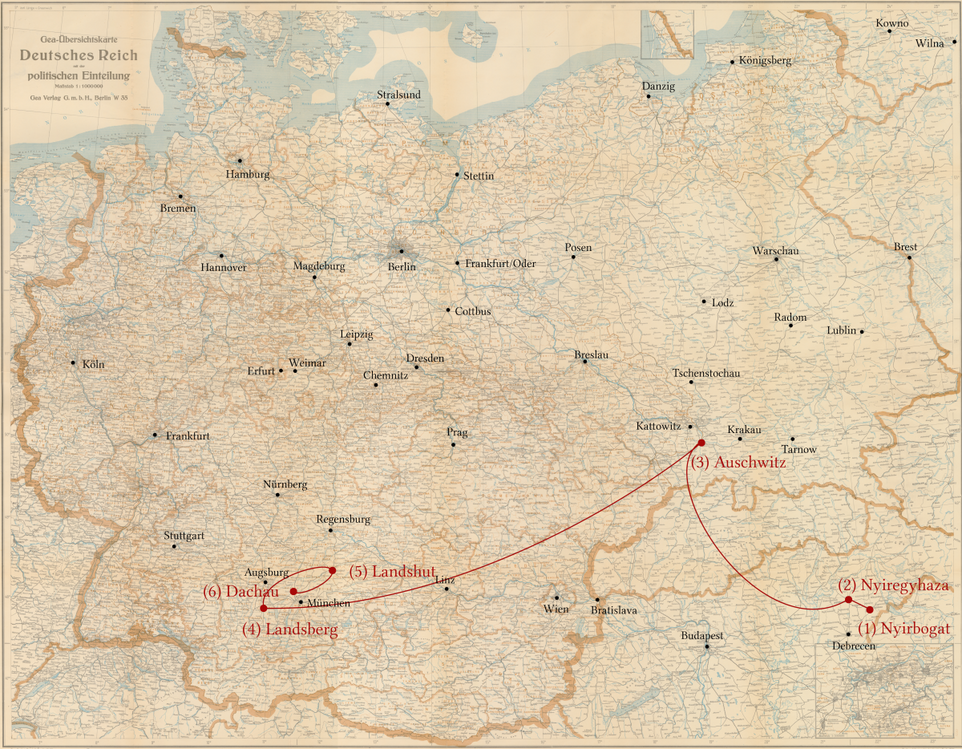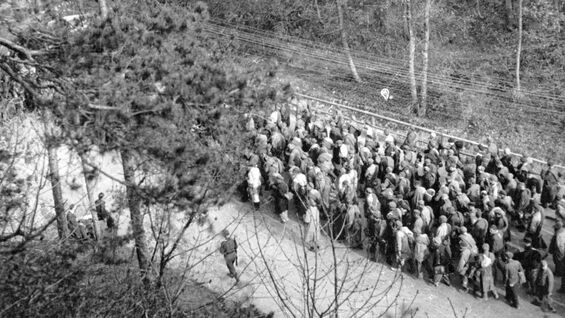The Biography of Simon Weisz, Nyirbogat
Short biography and stations of his persecution
- born on 3.2.1930 in Nyirbogat/Hungary
- 1944 Nyiregyhaza ghetto
- April 1944 to September 1944 Auschwitz concentration camp
- September 1944 to January 1945 Dachau concentration camp/Landsberg subcamp
- January 1945 to February 1945 Dachau concentration camp/Landshut subcamp
- February 1945 to May 1945 Dachau concentration camp
- Hungary, Austria, West Germany, Italy
- 1948 Canada
- 1957 USA
Simon Weisz lost his mother, two brothers and two sisters during the persecution by the Nazis.
Before the persecution
I am submitting this affidavit in connection with my application for compensation for damage to body and health.
Before the outbreak of the persecution measures, I lived with my parents and my four younger siblings in Nyirbogat. I was a strong, healthy child and attended school. After 1943, it was not possible to continue attending school, as anti-Semitic measures had already begun at that time. My family lived in secure circumstances. My father owned a small general store. My home was occupied by the Nazis in the spring of 1944 and that was the beginning of my ordeal.
We were soon driven into the ghetto, where we lived under oppressive conditions.
Source: Unless otherwise stated: Konrad Kittl files, Simon Weisz affidavit
| Ghetto Nyiregyhaza | |
|---|---|
| Place: | Nyiregyhaza (Nireguhaza, Niereghaza, Niregshasa) |
| Area: | Hungary, Szabolcs region |
| Opening: | 16.04.1944 |
| Liquidation: | 13.07.1944 |
| Deportations: | From May 14, 1944 to Auschwitz |
| Remarks: | In May 1944, there were 17,580 people in the ghetto, 5,000 of whom came from the town itself and the rest from the surrounding area. Between the end of April and mid-May, the Jews were taken to 3 agricultural estates outside the city. From here they were deported to Auschwitz.</td |
| Source: | Encyclopedia of Jewish Life, 2001; Braham: Politics of Genocide, GA Glass 20.02.2006, JCC Dr. Hoppe |
| Date of the supplement: | Feb. 16, 2011 |
| Source: Ghetto list 2014 | |
Auschwitz
Then we were dragged onto a cattle train and taken to the Auschwitz concentration camp. My beloved mother and my two brothers and two sisters were immediately sent to the gas chambers and I never saw them again. I was separated from my father. I was first taken to the so-called children's camp. Here we were kept in quarantine for almost two months because there was a scarlet fever epidemic. We were hardly given anything to eat and were crammed into barracks. After that I was sent to the gypsy camp. On one of our high Jewish holidays, I was selected for the crematorium. In a panic, I ran away from the group and saved myself. As I was quite tall for my age, I avoided being selected again.
Landsberg
In September 1944, I managed to smuggle myself onto a transport that was supposed to go to Landsberg. I said I was much older. In Landsberg, although I was still a child, I had to do the hardest men's work. We were made to do earthworks. Due to the miserable treatment, the hunger and the fact that we had no protection against the cold, I became ill. I got a high fever and became very weak. Medical help was out of the question. I was just left in the barracks. One day, an SS officer came and inspected us. He beat me up in the most brutal way and forced me to continue working.
| Subcamps of the Dachau concentration camp | |
|---|---|
| Location | Kaufering camp I, Landsberg |
| Area | Bavaria |
| Opening | 22.06.1944 (first mention) |
| Closing | The date of the "evacuation" to Dachau cannot be determined; / the liberation by the US army took place on 27.04.1945 [LIT] |
| Deportations | A total of 268 prisoners were transferred from the Kaufering camps to the Leonberg satellite camp of the Natzweiler-Struthof concentration camp [LIT]; on April 24, 1945, around 1,500 prisoners were sent on a "death march" via Schwabenhausen to Emmering, where they were transported by train to the Dachau concentration camp. |
| Prisons | About 3,000-5,000, mainly Jews |
| Gender | Men |
| Employment of the prisoners at | Fa. Moll, Geiger company, Kaufering OT construction management |
| Type of work | Water and sewer work, work on the bunker construction site |
| Comments | The Kaufering satellite camp around Landsberg and the satellite camps around Mühldorf were created in connection with the plans for the so-called "Jägerstab". This was an attempt to break the air supremacy of the Allied forces by increasing the production of fighter planes. To this end, huge concrete bunkers, "Jägerbauten", were to be hastily erected from mid-1944, into which the production facilities that had been severely damaged by bombing raids were to be relocated. Under the direction of OT, four companies were commissioned to build the bunkers: Leonhard Moll was responsible for the "Weingut II" bunker for the "Ringeltaube" project near Landsberg, Karl Stöhr for "Walnuß II" and Philipp Holzmann for "Diana II". All construction sites were located in the northwest of Landsberg. The Polensky & Zöllner company was to build the "Walnuß I" bunker near Mühldorf to the south of Mettenheim. As the demand for labor could not be met by "regular" workers, numerous forced laborers, prisoners of war and, above all, concentration camp inmates were transferred to Landsberg and Mühldorf. As only a few existing buildings could be used, the prisoners were confronted with improvised, completely inadequate accommodation and plagues of vermin and epidemics broke out within a very short time. A total of around 30,000 prisoners were deported to the Kaufering camps. On average, there were probably 10,000-20,000 people in the camps. The prisoners were almost exclusively Jews and came to Bavaria mainly via the Auschwitz and Stutthof concentration camps or directly from Hungary. From January 1945, prisoners were mainly deported to the Mühldorf and Kaufering camps from camps in the Reich territory. Kaufering Camp I was renamed from III to I and was the main camp of the Kaufering complex. The SS commandant's office was also located there. As hardly any documents on the transfers to or from the Kaufering camps have survived, the number of people who perished cannot be determined. It is estimated that almost one in two died. Transfers from the camps were certainly tantamount to the death of the prisoners. [The information on employers and type of work is partly taken from the Ludwigsburg investigations and the ITS. Raim 1992 points out inconsistencies and incompleteness in this regard |
| Source: deutschland-ein-denkmal.de | |
Landshut
In January 1945, we were driven to the Landshut concentration camp. Despite my terrible condition, I was put to work in mechanical engineering. I fell ill with severe dysentery and again received no help. The treatment in this camp was appalling. About half of my fellow sufferers died. Those who were still alive could hardly be described as human beings. I will never forget the horror of that time. We were beaten every day.
| Außenlager des KZ Dachau | |
|---|---|
| Ort | Landshut |
| Gebiet | Bayern |
| Eröffnung | September 1944 (erste Erwähnung) |
| Schließung | 05./06.02.1945 |
| Geschlecht | Männer |
| Einsatz der Häftlinge bei | OT-Oberbauleitung Amt B.G. (Bedeutung der Abkürzung nicht bekannt |
| Quelle: deutschland-ein-denkmal.de | |
Dachau
Then the camp was dissolved and we were taken to Dachau. I didn't have to work in Dachau. It was just waiting to die. I lay on my cot together with five other prisoners. Sometimes it happened that those who were next to me died. I had a high fever here and probably typhus fever. As the front approached - a few days before the liberation - we were dragged on an extermination march, on which I was then liberated.
After the Liberation
After my liberation, I immediately received medical treatment. When I was able to stand on my feet again, I went back to Hungary to look for my family, but was unable to find anyone and, fearing further persecution, fled via Austria to West Germany and lived here and later in the DP camps in Italy until I emigrated to Canada in 1948. In 1957 I immigrated to the United States.
Due to the cruel experiences during the time of persecution, the constant fear of death, the loss of my mother, my four siblings, the hard mental labor I had to do as a child, the constant abuse and illness, the hunger, the deprivation, I am still in poor health today.
I declare my willingness to be examined by a medical officer.
I confirm the accuracy of my statement with my signature in lieu of an oath.
Notes
Office for Compensation
---
Notes
- The Jews of Nyirbogat were taken via Nyiregyhaza to Nyirjespuszta and from there to Auschwitz; source:
https://dbs.bh.org.il/place/nyirbogat
Picture Credits
- Birkenau, Poland, 27/05/1944, A selection on the platform. Yad Vashem, AS 10BO1
- Stadtarchiv Landsberg am Lech, Bildarchivnummer 3232


